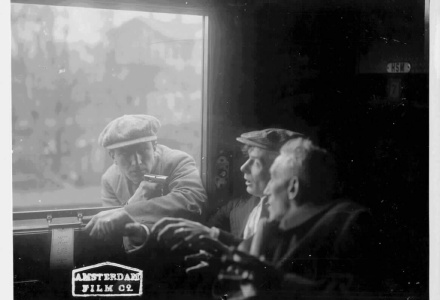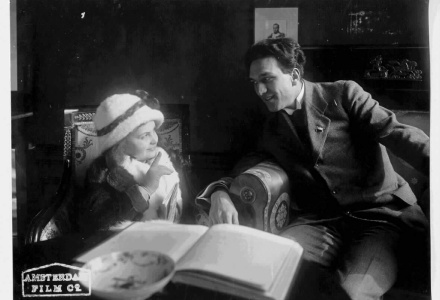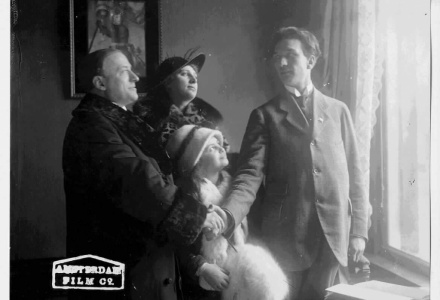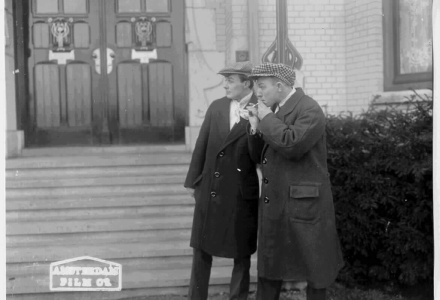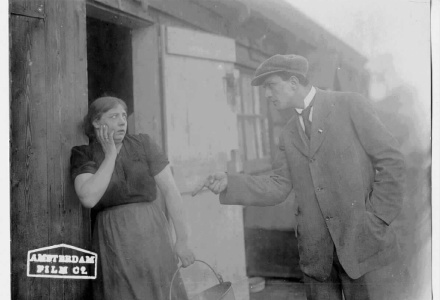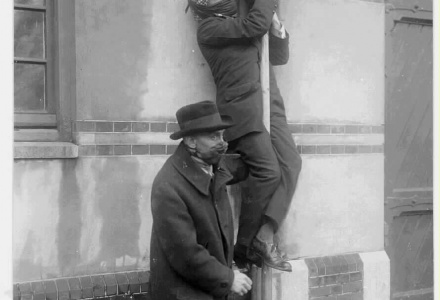Genie tegen geweld
Summary
Detective Pim Bruce tries to solve a case of diamond theft and murder.
Van Duylen, representative of a diamond syndicate, brings to Amsterdam the "Koh-I-Noor II", the largest diamond ever found. In one of the city's oldest diamond-cutting establishments it is cleft and the nine small stones are polished. Escorted by detectives, Van Duylen takes the stones home and puts them in his burglar-proof safe. He tells his wife that its doors are electrically charged and that anyone opening them in the wrong way will immediately be electrocuted.
Two suspicious persons, Jack the Acrobat and the lion-tamer Feenstra, prowl around Van Duylen's villa, inspecting the doors and windows. They go to their crony, the notorious burglar Nelis Veerman, to discuss their plan to steal the diamonds.
One evening, when Van Duylen is away on business, a family friend, Lamberts, visits Mrs van Duylen and plays chess with her. In the garden, three shadowy forms emerge from the shrubs and silently climb through a window. So as to be undisturbed, they screw up the front door. When Lamberts wants to go home, he cannot open the door. Mrs van Duylen advises him to climb through a window. As he is doing so, he is observed by a policeman, but his explanation is accepted.
Van Duylen comes home and cannot enter. When his servant finally manages to open the door, Van Duylen suspects trouble. He hurries to his office where he finds his wife sitting on a chair in front of the open safe. She has been stabbed. The precious stones are missing. The police are called and, as he is suspected of having committed the crime, Lamberts is arrested.
Mrs Lamberts is greatly distressed. Her little daughter, reading about Sherlock Holmes, believes that the famous detective will be able to prove her father's innocence. A policeman explains that Holmes is an imaginary person, but to comfort the child he gives her the address of a real detective: Pim Bruce, Willemsparkweg 6. Charmed by the little girl, Pim promises to investigate the matter.
After visiting Van Duylen, Pim expounds his theory: Mrs van Duylen must have surprised the burglars, who then murdered her. Whoever opened the safe must have been killed too. He takes a list of all the people who died on the evening of 12th February to the police-station and asks if one of the names is that of a registered criminal.
Informed that a certain "N. Veerman" was a well-known burglar, Pim goes to the cottage of the widow and, taking her by surprise, says: "Your husband didn't die at home. I know everything. I also know who his accomplices are." The woman stays silent. Believing that she will warn her husband's comrades, Pim follows her to a café where she talks to two men.
Chasing the two, Pim is trapped in the house where Feenstra keeps his lions. He escapes just in time to see the criminals jumping into a moving train. Looking at a map, Pim notes that the train makes a large bend on its way to the next city. He runs to a paddock, springs onto a horse and gallops to the crossing. As the train approaches at a speed of 70 m.p.h., Pim throws himself flat between the rails and, as the last carriage passes, he grabs the buffers and swings himself up.
Clambering to the compartment where the criminals are sitting, Pim threatens them with a revolver and is able to handcuff them. At the next station they are handed over to the police. Mr Lamberts is released and he, his wife and little Elsa express their gratitude to Pim Bruce for what he has done for them.
Information
Images
Cast
Actor
-
Mrs. Lamberts
-
Veerman's wife
-
Lamberts
-
Feenstra
-
Jack the Acrobat
-
Employee in the diamond-cutting establishment
-
Mr. Van Duylen
-
Nelis Veerman
-
Police officer
-
Employee in the diamond-cutting establishment
-
Mrs. Van Duylen
-
Dealer in diamonds
-
Pim Bruce
Crew
-
Camera
-
Director
-
Producer
Technical notations
Resources
G. Donaldson, Of Joy and Sorrow. A Filmography of Dutch Silent Fiction, Amsterdam (1997), pp. 149-150
De Film-Wereld, No. 17, 1 juni 1918, pp. 1-2
De Telegraaf, 29 april 1916
De Bioscoop-Courant No. 29, 7 april 1916, p. 10
De Bioscoop-Courant No. 31, 21 april 1916, pp. 12-13
De Bioscoop-Courant No. 32, 28 april 1916, p.6, pp. 14-15
De Bioscoop-Courant No. 33, 5 mei 1916, p. 6
De Bioscoop-Courant No. 43, 14 juli 1916, p. 16
De Kinematograaf No. 167, 31 maart 1916, p. 2264
De Kinematograaf No. 171, 28 april 1916
De Kinematograaf No. 172, 5 mei 1916, pp. 2320-2321
more information
If you are looking for more material from our collection, please contact Film Sales:
sales@eyefilm.nl
phone +31 (0)20 5891 426
